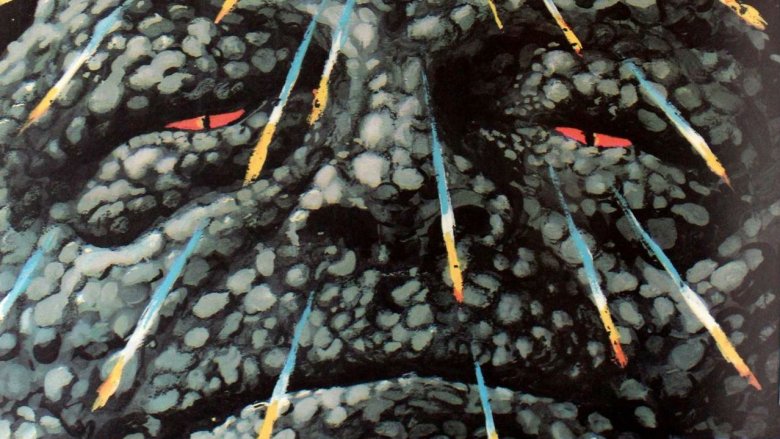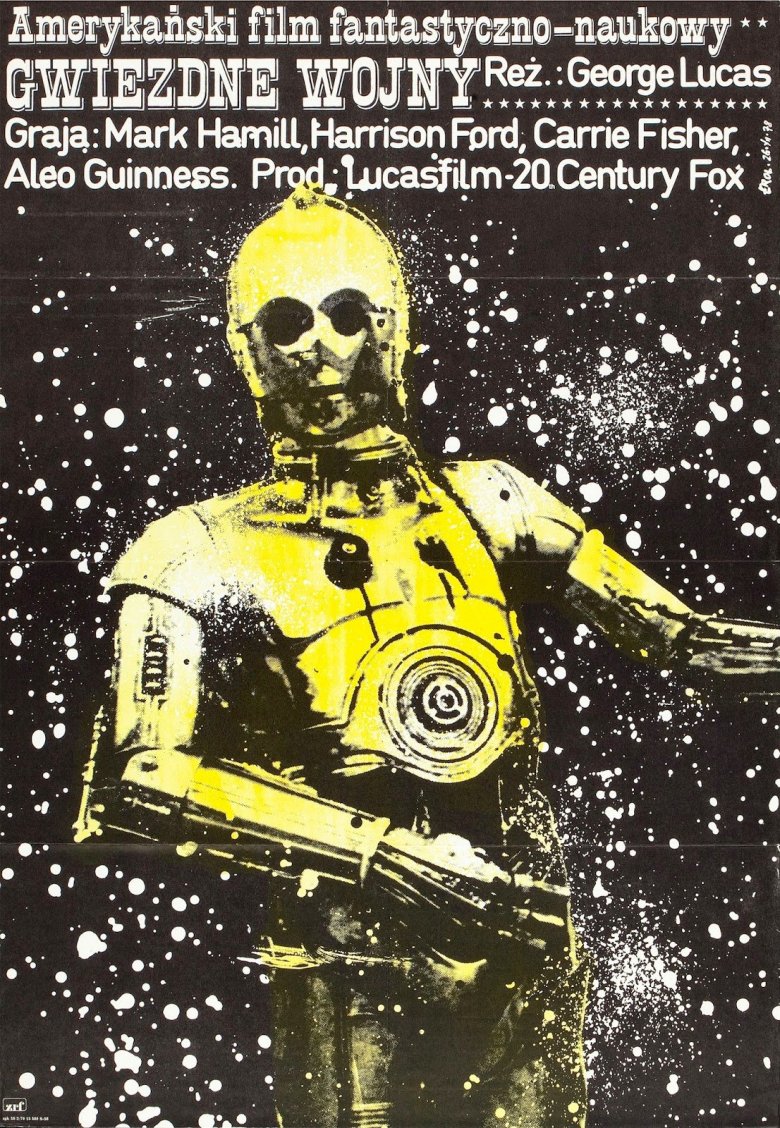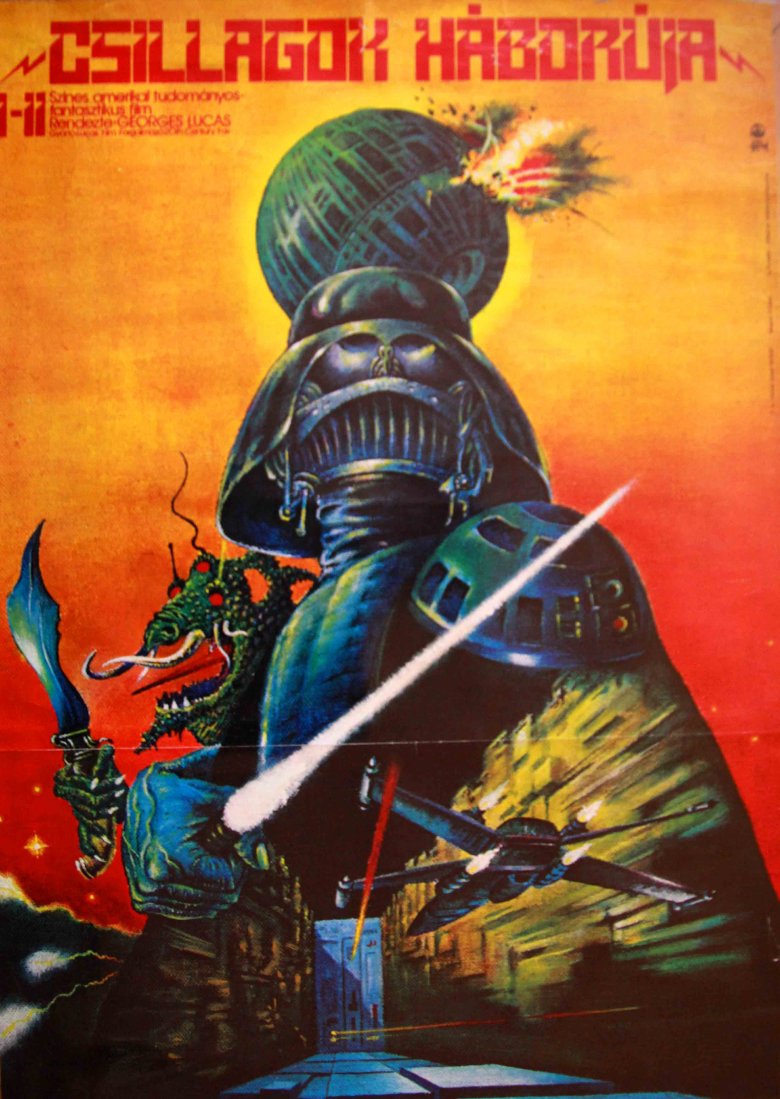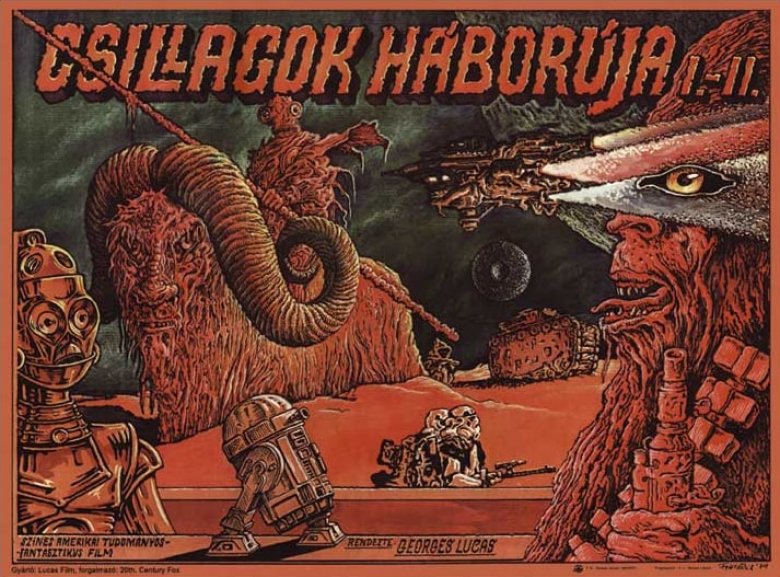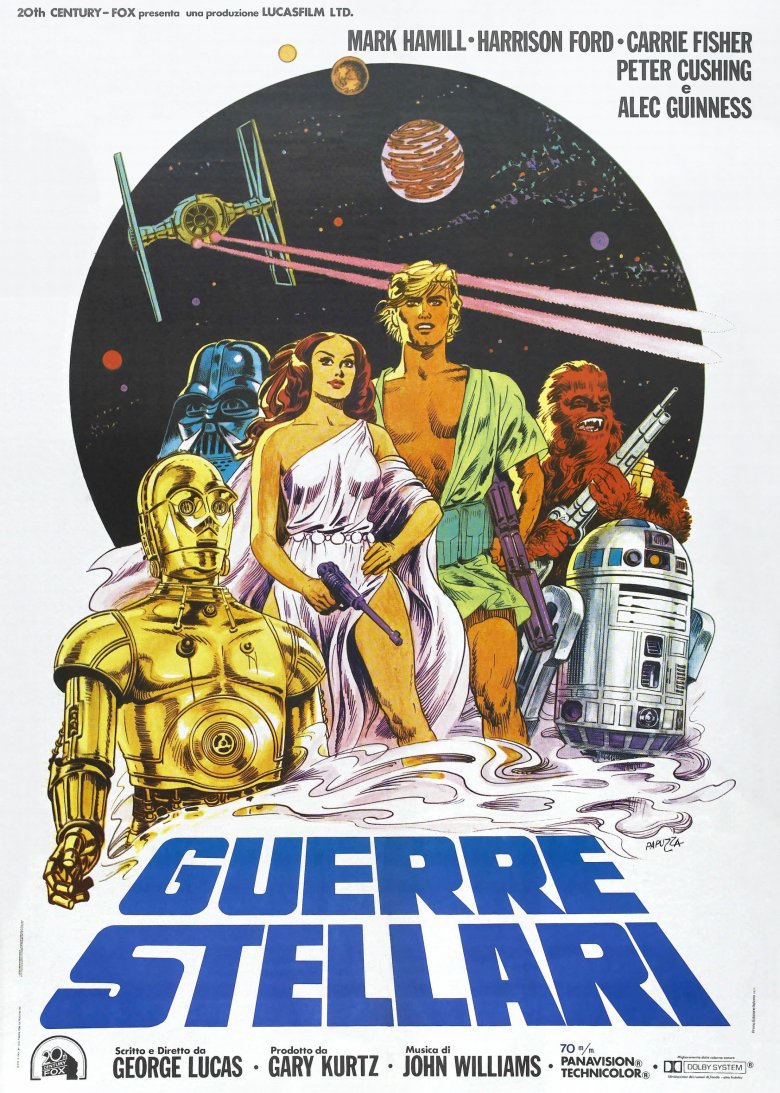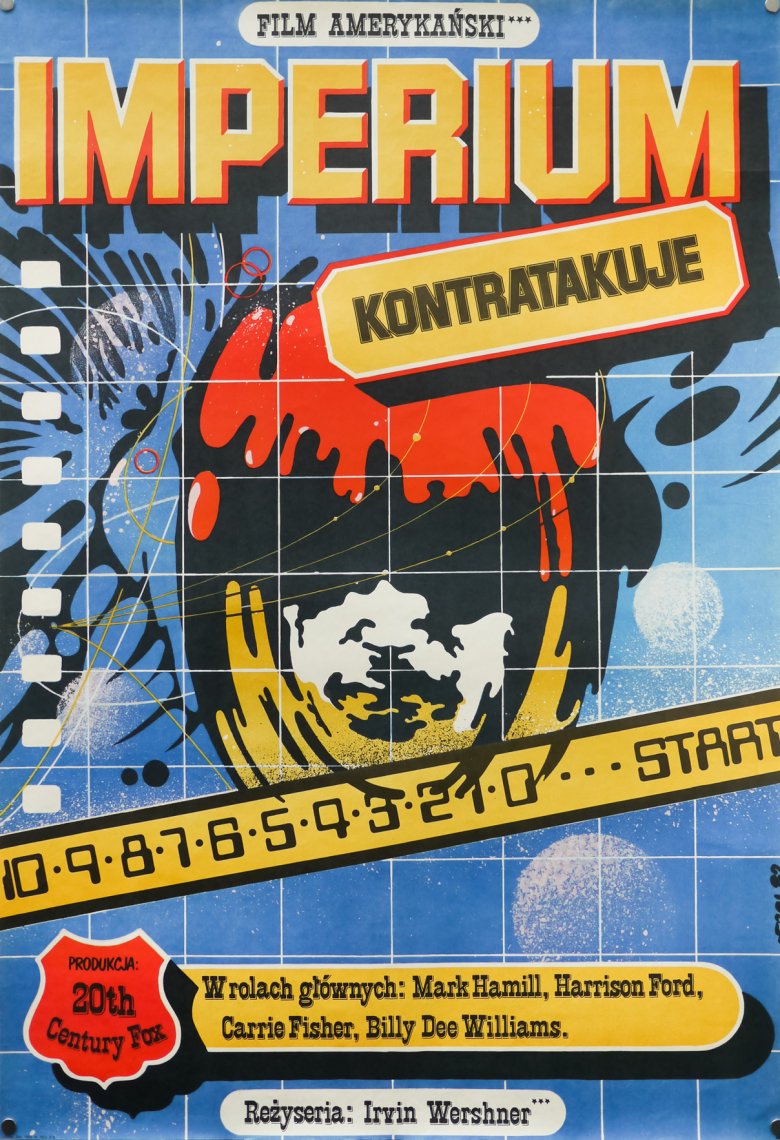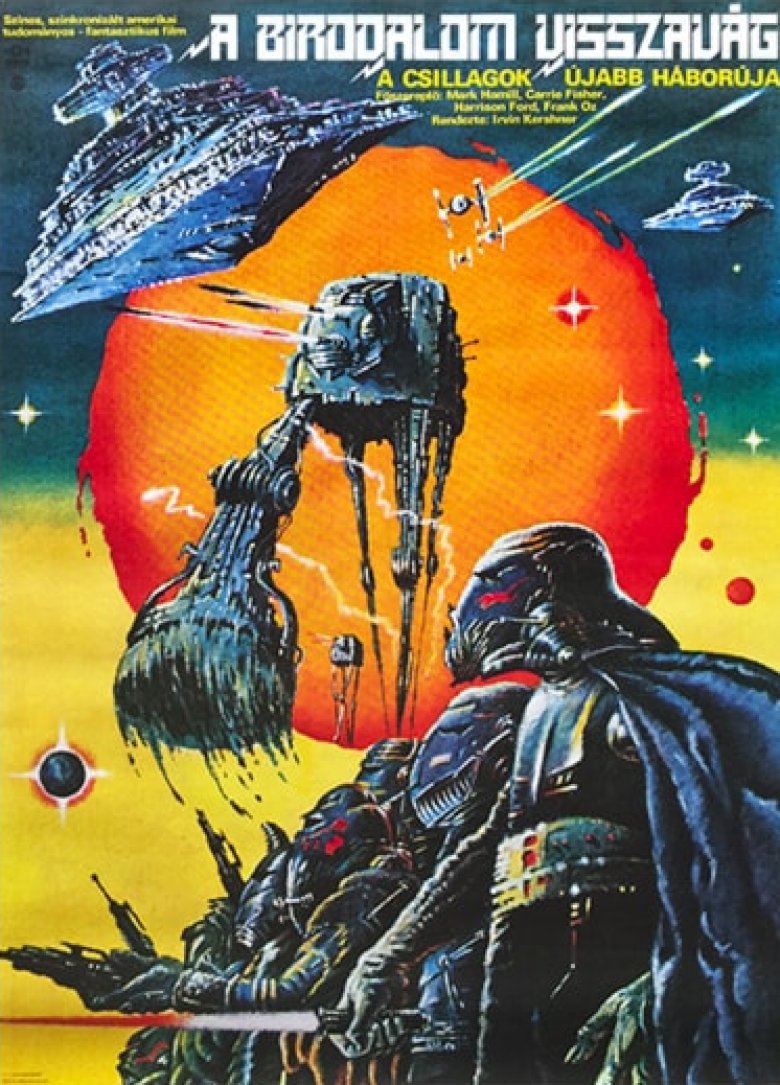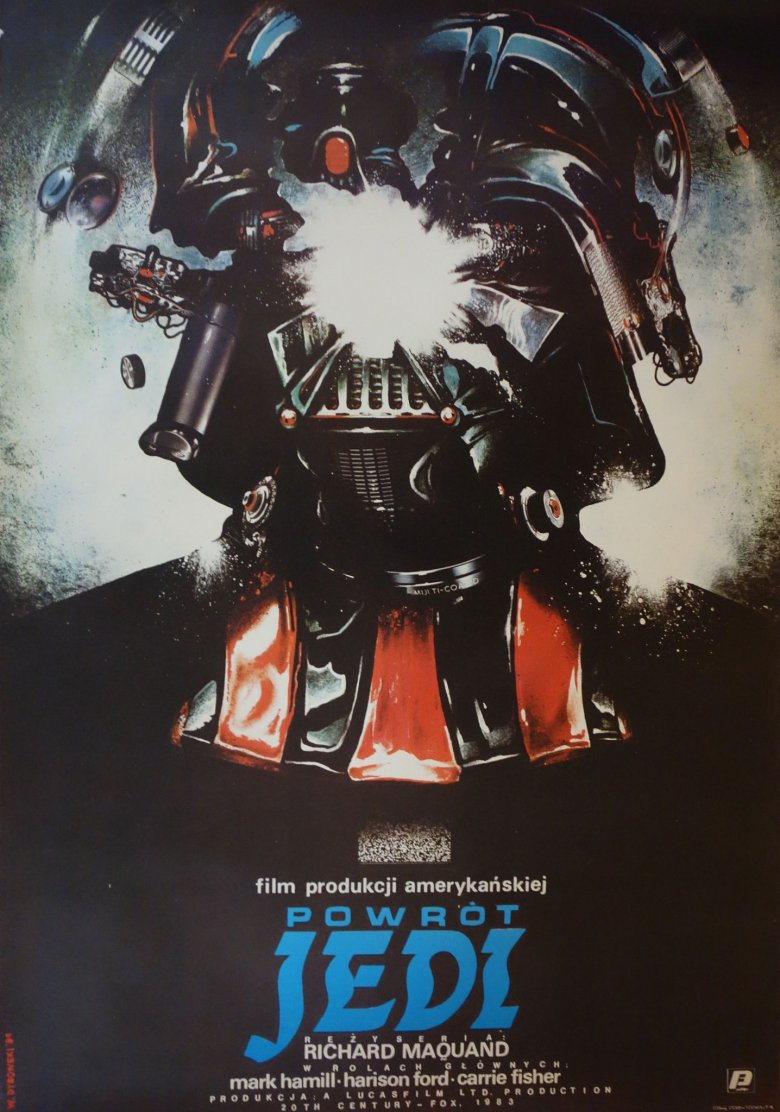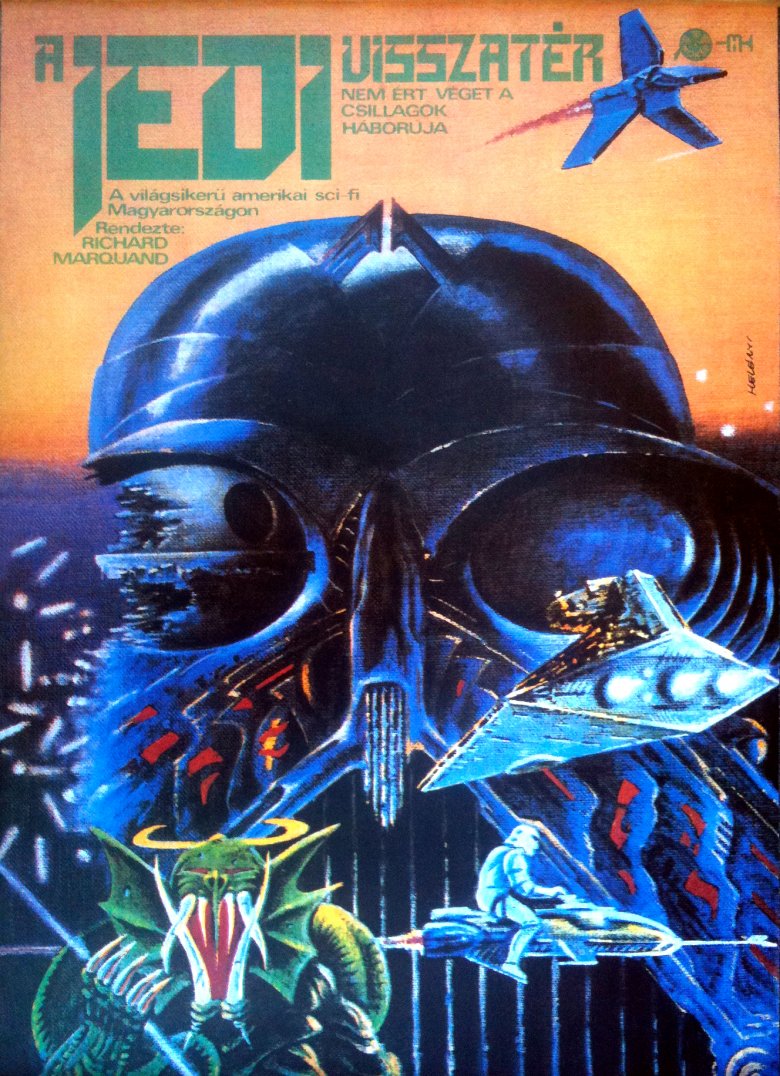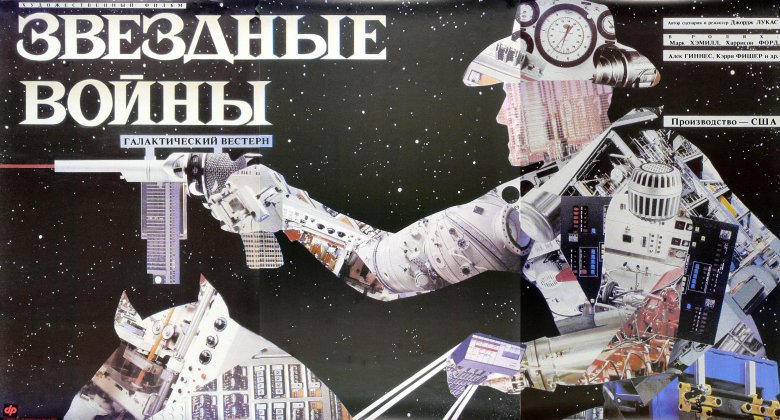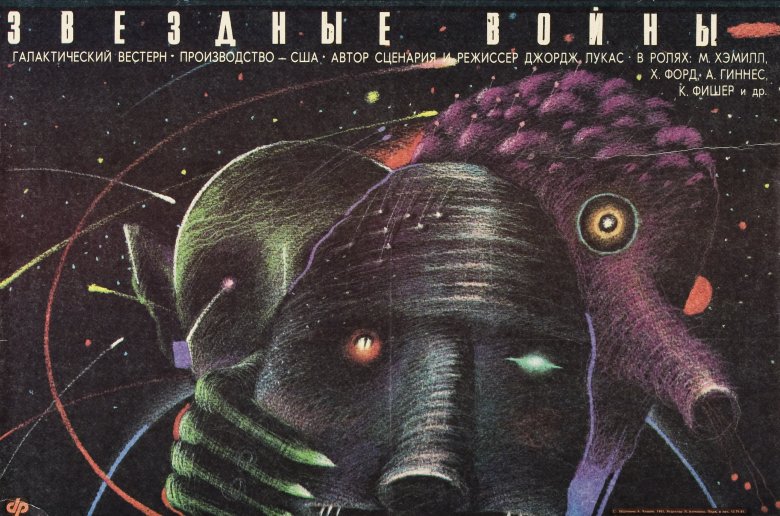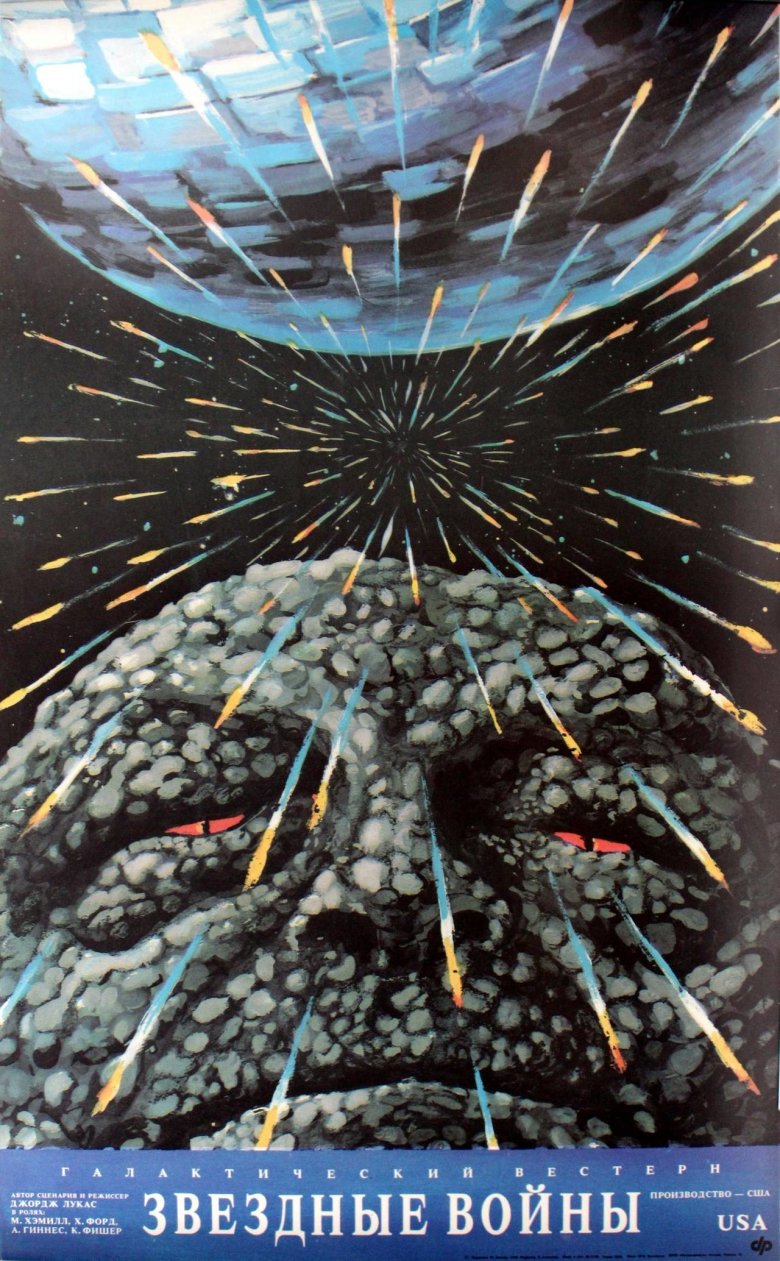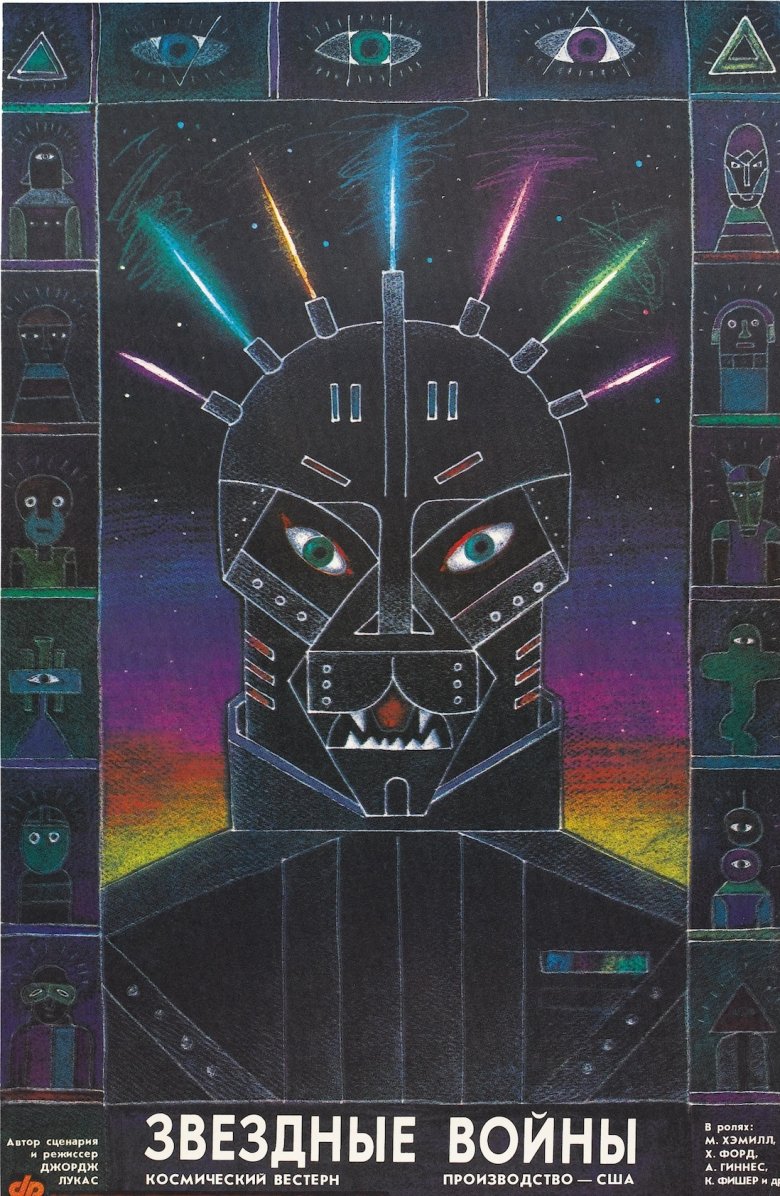The Weirdest Foreign Star Wars Movie Posters
Let's be real — Star Wars is weird. Like really, really weird. After all, we're talking about a universe that features little teddy bears with spears taking down giant, chicken-shaped robotic killing machines, a sluggy crime boss sucking down squealing Klatooine paddy frogs, and a little old, long-eared green goblin-looking Jedi master riding around on rebel pilot's back while making him move stuff with his mind. And that's just the original trilogy. Let's not talk about the Gungans.
That said, the actual weirdness of the films themselves pales in comparison to the oddities found on their foreign movie posters. Whether we're talking about panther-looking Darth Vaders, scimitar-wielding lizard people, or absurd designs having literally nothing to do with the films, foreign countries weren't afraid to take some... let's say... 'artistic liberties' when it came to advertising Star Wars.
A New Hope (Poland) — Jakub Erol
Get close to the screen and have a nice, long stare into those dark, lifeless voids where C-3PO's eyes should be. Now, be honest...how does that make you feel?
When it comes to Polish movie posters, artist Jakub Erol reigns supreme. Though it's hard to pin down Erol's style — since you never really know what you'll find next in the artist's body of work — almost every poster he made has, at the very least, a touch of weirdness. Take this poster for A New Hope, for example, which features a blank, seemingly lifeless C-3PO floating through space and time. It certainly doesn't give the uninitiated Star Wars movie goer a particularly accurate impression of what's in store. It does, however, make you feel like the gold-plated robot is sucking your soul right out of your body with those black holes posing for eyes. So, there's that.
By comparison, Erol's stoned, slightly-perverted looking E.T. poster is nothing particularly disturbing — but don't let that one fool you! Erol wasn't afraid to horrify. His take on Raiders of the Lost Ark, for example, looks like something straight off a Satanic death metal band's T-shirt. And that doesn't even don't even touch on Alien. How do you out-weird H.R. Giger? Erol found a way.
You can stop staring at C-3PO, now. Everything will be all right.
A New Hope (Hungary) — Tibor Helényi
One of these things is not like the other, and it probably took you the entirety of two seconds to spot which asset on this poster doesn't belong.
It's a common misconception among those who've seen his posters that famous Hungarian artist Tibor Helényi didn't actually watch Star Wars — which is understandable, given that Darth Vader doesn't really look like that, and the fact that Death Star didn't exactly burst a seam as much as instantaneously explode. (Talk about a spoiler.) Oh yeah... and there's definitely no green, scimitar-wielding, tusked insectoid characters in A Hew Hope, either.
But, believe it or not, it was all part of Helényi's plan. In a Hungarian-language interview published on kunszt.reblog.hu, the artist claims that he did, indeed, watch and enjoy each film before creating their respective posters. The bizarre aspects — like the green monster — stem not from forgetfulness or ignorance. Rather, the strangeness of the posters, as well as Helényi's artistic liberties, serves to illustrate the Hungarian's interest in differentiating his work from typical Western European and American film posters.
If differentiation was Helényi's goal, mission accomplished. Now let's blow this thing and go home.
A New Hope (Hungary) — András Felvidéki
Just stop a moment and take a look at this András Felvidéki poster for Star Wars: A New Hope. Take a good hard look.
What stands out to you as the most disturbing? Is it Chewbacca's ferociously eager tongue action? Is it C-3PO's aghast expression upon witnessing Chewbacca's ferociously eager tongue action? Or is it the fishy-looking Tusken Raider atop a monstrous Bantha, which, for some reason, has an uncannily evil human face? Or maybe it's just the entire thing, taken together, which makes your skin crawl — like you've been transported to the Upside-Down, and A New Hope was directed by Barb's dead body.
Felvidéki is well-known in Hungary for his postmodern interpretations of old etching and engraving techniques, as well as his tendency towards the humorous and grotesque. He associated with Neo-Avantgarde artists of the 1970s — a time at which the Soviet Union still had a keen interest in controlling Hungary's rebellious counter-culture movements — and even played in a rock band with fellow Star Wars poster artist Tibor Helényi, whose work is also very firmly situated in the weird.
At least Felvidéki gave us a familiar-looking R2-D2 on this poster, possibly to keep us from getting completely lost in the madness.
A New Hope (Italy) — Michelangelo Papuzza
Italian artist Michelangelo Papuzza's poster for Star Wars: A New Hope is certainly a lot less daring and disturbing than those made by his central and eastern European counterparts. But it's still kinda weird.
In place of Neo-Avantgarde bizarreness, strange perspectives or disconcerting imagery, Papuzza chose instead to go with a comic book art style highly reminiscent of the legendary Eisner Award-winning Russ Manning's Star Wars comic strips, which ran in Los Angeles Times-distributed newspapers from 1979 to 1984. As a result, we're left with a brightly-colored, and relatively accurate, depiction of A New Hope — despite Luke Skywalker's proudly-displayed He-Man pectorals competing with C-3PO's glamorously buff and shiny bod for Guerre Stellari's Mr. Galaxy, and a particularly well-endowed Greek goddess posing as Princess Leia showing off some serious thigh action. Darth Vader, R2-D2, Chewbacca and the TIE fighter all receive beautifully accurate representations, however — though Luke's father (spoiler alert!) does, oddly, have eyes... which only serves to make him even more intimidating.
Notably absent, of course, is Harrison Ford's character... though we're not sure where Papuzza could've squeezed him in. Thus, we can only speculate as to how big Han Solo's muscles would've been.
The Empire Strikes Back (Poland) — Jakub Erol
Let's be honest. If you didn't read Polish — and if Mark Hamill's, Harrison Ford's, Carrie Fisher's and Billy Dee Williams' names were printed — you'd have no idea this is an Empire Strikes Back poster. Rather, at first glance, it comes off as some kind of Orwellian, Nineteen Eighty-Four-esque Big Brother propaganda poster — with subtle hints of fascism — while still remaining superbly cemented in space-age science fiction. So... what gives?
Jakub Erol, like his Hungarian counterparts, had the luxury of being able to operate with total artistic freedom while making his Star Wars posters. The Soviet Union allowed, to some extent, western films to be shown in Poland and Hungary, but Hollywood had absolutely no say in how their promotional materials were made — hence why these weird posters were even allowed to exist in the first place. Because capitalism simply wasn't going to happen, state-controlled institutions took charge of commissioning artists — like Erol — to interpret "Film Amerykański" in their own ways. Therefore, artists were given almost complete and total freedom to make their posters as weird as they wanted — assuming, of course, they weren't actively trying to subvert state power.
Whether or not this Imperium kontratakuje poster appears to you as a statement about totalitarianism is up to personal opinion, but it's safe to assume that more than a few Communist Bloc Star Wars fans — and artists — drew parallels between the Galactic Empire and the Soviet Union.
The Empire Strikes Back (Hungary) — Tibor Helényi
The second of Hungarian Tibor Helényi's Star Wars poster trilogy lacks the extraneous elements of his first and third (which you'll see later), though that doesn't make it any less weird. (Or awesome.)
As is characteristic of Helényi's illustrations, his movie poster for A Birodalom visszavág (The Empire Strikes Back) features a spectacular use of perspective. The central figure of a lumbering AT-AT stepping its frighteningly spindly legs gets a little too close for comfort. The gorgeous rendition of a highly detailed Star Destroyer is also a force to be reckoned with, which also shows off Helényi's artistic skills. Of course, the icing on the intimidating cake is the frightening, monstrous version of Darth Vader, rolling squad deep with his team of Imperial goons. One look at this rare poster and it becomes clear — the Empire is most definitely striking back.
This poster, along with his others, was auctioned off on May 31st, 2015 by the Budapest Poster Gallery. It sold for a whopping $14,250, making it the most expensive of Helényi's trilogy. Interestingly, the artist himself never even knew that people took such a keen interest in his work, nor did he know that people collected them. In a Hungarian-language interview, Helényi claimed to have never really followed the post-debut life of his posters — which only took about a week to make, each.
Helényi passed away in 2014, so we can only speculate as to whether or not the artist knew just how valuable his Star Wars renditions really are.
Return of the Jedi (Poland) — Witold Dybowski
At first glance, this Polish poster of Darth Vader's exploding head might not seem particularly weird or unusual. But before you dismiss it as 'kinda meh,' take a closer look.
If you pay close attention to the finer details of this Powrót Jedi (Return of the Jedi) poster — which features a not-so-subtle spoiler of Darth Vader's head exploding like the second Death Star — you can spot some actual camera parts comprising Vader's helmet. At the base of the helmet are two knobs or dials, and the words "multi-coated" are printed around the neck. Close inspection also reveals a camera grip, some inner mechanics and wiring, and other detailed, real-life parts cleverly Easter-egged in Vader's iconic breathing apparatus. Major points for ingenuity, here.
The melding of Vader's breathing technology with actual photographic technology will come as no surprise to anyone familiar with Polish artist Witold Dybowski — who today is most widely known in Poland, Germany, and Austria for his photography.
Return of the Jedi (Hungary) — Tibor Helényi
The last of Hungarian Tibor Helényi's famous Star Wars poster trilogy, this somewhat bizarre interpretation of A jedi visszatér (Return of the Jedi) is the least valuable of the collection. Indeed, at first glance, it does stand out as the least engaging of the three — though there is one obvious element which is sure to make any Star Wars fans scratch their heads.
Standing front and off-center is some sort of strange, green lizard creature with yellow horns, a set of large tusks, and some claws you definitely don't want any part of. The monster instantly draws comparisons to the out-of-place green monster in Helényi's poster for A New Hope. And like that first monster, this one was also meant to be a joke. Because Helényi was given complete and total freedom to craft each poster as he saw fit, the artist included the monster simply because he wanted to, and because he could — ultimately ensuring that his posters would, indeed, be forever differentiated from American and Western European versions.
Helényi claimed his job was the second best job (behind medical doctor) in all of Hungary during the original Star Wars era, when the central European country was still under the yoke of the Soviet Union. Not only was he allotted total artistic freedom, but his posters were displayed all over Budapest, and he was paid a handsome 4,000 Hungarian forint per poster by government authorities. "Just don't call about a Soviet film," he said.
Star Wars (Russia) — Yury Bokser and Alexander Chantsev
Even when compared to the undeniably weird posters from Soviet-controlled countries like Hungary and Poland, posters from Mother Russia are truly from a galaxy far, far away.
Despite the best efforts of Soviet authorities — who only allowed important people like diplomats and high-ranking government officials to watch the trilogy — pirated tapes of Star Wars existed, and a whole sector the the Soviet black market was devoted to dubbing illegal copies. The films were dubbed "galactic westerns" in the U.S.S.R., and were officially titled War of the Stars. According to Russia Beyond the Headlines, A New Hope was retitled as "Horrors on a Truly Cosmic Scale," and the principle characters were renamed "the round-faced princess," "the village youth," and "the old knight of the Round Table."
As for this poster — the first of Yuri Bokser's and Alexander Chantsev's four 1990 illustrations celebrating the official release of Star Wars in Russia — the difference between what Star Wars really is and what Star Wars was believed to be is obvious. In fact, the only half-way accurate aspects of this poster are the laser-shooting revolver and black pieces of what looks like Darth Vader's chest piece. Cowboy hats and horses, however, are notably absent from George Lucas' trilogy.
Star Wars (Russia) — Yury Bokser and Alexander Chantsev
We know what you're thinking. Nothing says Star Wars like a pink cyclops anteater with a lumpy head, and a green chrome-domed alien peeking from behind a grey winking vacuum-nosed space monster. Wait... that's not what you're thinking?
Winning the award for the most unrecognizable official Star Wars poster ever made, Yury Bokser's and Alexander Chantsev's trippy vision for America's "galactic western" is beyond bizarre. Aside from the fact that it features the relevant casting information — and that there's actual stars in the background — nothing about this poster has anything to George Lucas' creation. Seriously... just look at it.
Despite being banned in the U.S.S.R., the hype behind Star Wars was very, very real. In February 1988, the country held a Days of U.S. Cinema festival, with — according to Russia Beyond the Headlines — Richard Gere, Susan Sarandon, and Tim Robbins notably attending. Scalpers jacked up ticket prices for the event by some 20 to 30 times the original price, which was gladly paid by those eager to see what The Empire Strikes Back was really about.
Spoiler alert! It doesn't have any of Bokser's and Chantsev's monsters. It does, however, have tauntauns!
Star Wars (Russia) — Yury Bokser and Alexander Chantsev
Not every one of Yury Bokser's and Alexander Chantsev's Star Wars creations was totally absurd.
Sharing almost equal parts on this Return of the Jedi-themed poster are a particularly larger-than-life Jabba the Hutt and the bottom of a presumably under-construction Death Star, making this poster at least somewhat related to Star Wars canon — especially when compared to the others. Adding a sense of depth to the illustration are the stars streaming towards the viewer, harkening back to a light-speed jump from the cockpit of the Millennium Falcon. All things considered, this poster seems to prove that the artists did actually watch the films — something one could never assume when looking at the rest of their work.
It wasn't until the year 2000 that the original Star Wars trilogy came to Russia — in licensed video format, to be specific. The actor behind C-3PO, Anthony Daniels, was the guest of honor at the official release ceremony — and was given the full-on star treatment by the foreign crowd. Unsurprisingly, the previously banned films were exceptionally popular among the Russian audience. The films were so popular, in fact, that Russian president Vladimir Putin appeared on the country's most popular satirical television show, Kukly, to play Luke Skywalker, alongside former president Boris Yeltsin's Obi-Wan Kenobi. Well, okay – the puppet versions of the famous politicians made an appearance, at least.
Star Wars (Russia) — Yury Bokser and Alexander Chantsev
Like the rest of Yury Bokser's and Alexander Chantsev's Star Wars posters, this one leaves us with more questions than answers.
For example, why does Darth Vader have the muzzle and teeth of a jaguar, and why can we see his eyes? Why is he spouting seven different colored lightsabers from his helmet? Why are there three different eyeballs above him? Better yet — why is he surrounded by a whole slew of animalistic, hand-drawn humanoid aliens, who appear to have been penciled-in by first-graders? Only the Force knows.
Today, Star Wars is as popular as ever in Russia. It's also as politically relevant. Parallels have been drawn between the evil Empire and the Soviet Union since the film series' creation, and Star Wars' eternal fight against evil and totalitarianism is not lost on the Eastern European audience. In 2015, a Russian-language meme titled "Empire Strikes Back" was created — in the style of the films' opening sequence — listing the names ruling elite, as well as the dates they joined the Communist Party. On top of that, one of the most popular Vladimir Putin-parody accounts on Twitter is @DarthPutinKGB — since everyone knows he joined the Dark Side a long, long time ago.
Anyway, the next time you pop in the original trilogy, just imagine if George Lucas had opted to make Darth Vader look like a jungle cat with lightsabers for hair. If that was the case, his admission to being Luke's father would've been really surprising.
